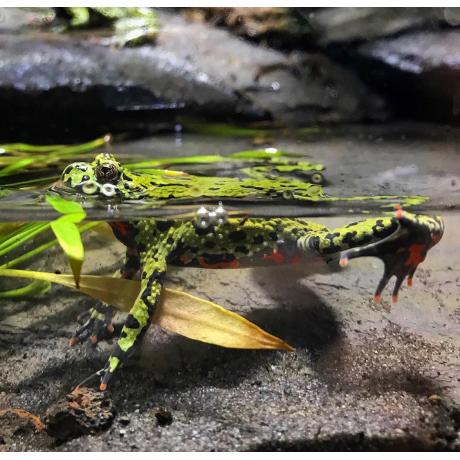

The Fire Bellied Toad used to be one of the most widely kept species of toad, now they are less common. Being easy to keep and maintain makes them great for beginners and they are always entertaining to watch.
These vibrant little toads have bright red, sometimes yellow-orange bellies with black blotches, each pattern is unique to each toad. The rest of the body is green or even brown with black markings and warts. A red tip is present on each toe, the back toes are large and webbed, which helps them to swim. Their eyes protrude from the top of their head and the eardrum is hardly apparent.
They grow to an adult size of 4-6cm (1.5-2.5"). The males are smaller, slender and have cushion-like pads (nuptial pad) on their thumbs. You will also find that the males have longer and stronger front legs once adult.
They can be found in parts of China, Eastern Russia, Europe and Korea.
These toads are terrestrial, but will use any space provided, therefore the glass terrarium should have plenty of floor space. For two frogs we recommend an absolute minimum of 60 x 45 x 45cm (24 x 18 x 18”) though larger is always better.
They are a very hardy species and are diurnal (active during the day) and require ambient temperatures of up to 20°C. They can withstand temperatures as low as 5°C but will not do well if temperatures exceed 30°C.
Fire Bellies require low level T5 UVB lighting that sits within the parameters of Ferguson Zone 1, this aids their circadian rhythm and helps them to produce vitamin D3 which is essential in the absorption of Calcium - keeping bones healthy and strong. Though many kept these without UVB for many years, it is proven beneficial to all amphibians and also helps keep their colours vibrant. This should be on for 12 hours during the day and turned off at night, and replaced once a year without fail.
There are options for housing this species. You can have a set-up of 50/50 land and water, fully aquatic with floating logs or mainly land with a large water dish. We find the 50/50 land and water, paludarium style enclosure suits them well, the addition of a filter helps maintain water quality. We recommend using treated tap water, bottled, or rain water as the chemicals and metals in tap water can cause health problems for amphibians. Humidity can fluctuate in the wild, but aim for anything between 60-80%.
They enjoy having plenty of ‘clutter’ in the enclosure such as dense foliage plants (live or artificial), cork bark and vines, these provide safe areas to hide, and offers enrichment and stimulates natural hunting behaviours.
Feed your toad a varied diet of live insects every few days.They will feed on small to medium crickets, hatchling locust and other small insects such as clean up crews such as Springtails and Isopods within the terrarium. It is important to use a good quality supplement powder to provide an essential calcium and vitamin boost to your toads. Providing additional Vitamin A is important as this is a vitamin which they can be more susceptible to becoming deficient in. The easiest method of application is to use a spare live food tub or ziplock bag to lightly dust the insects in supplement. We advise dusting your insects on every feed, alternating between calcium and vitamin powders according to manufacturers recommendations; this must be done throughout the duration of the frogs life.
Caution: When providing water for your amphibians, this MUST be treated with a de-chlorinating solution. The chemicals in tap water will harm and possibly kill your amphibians after a period of time.